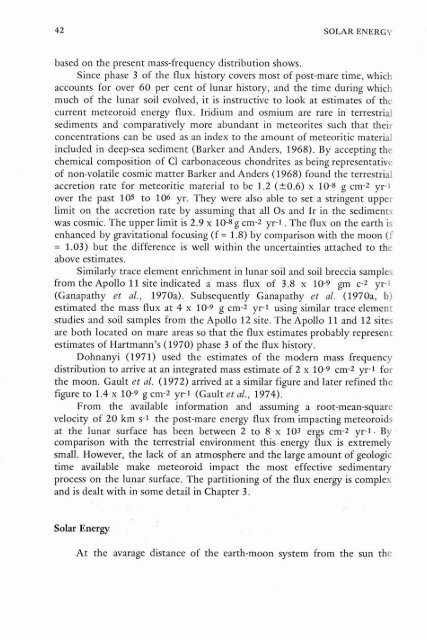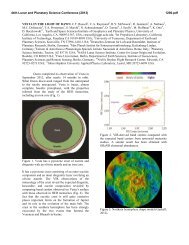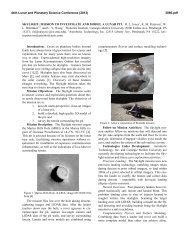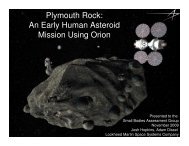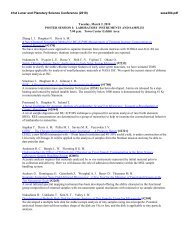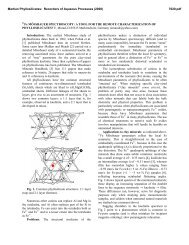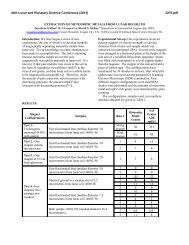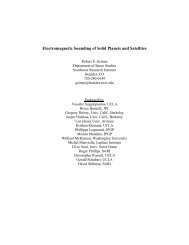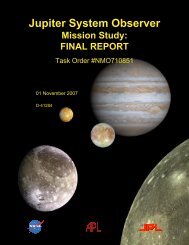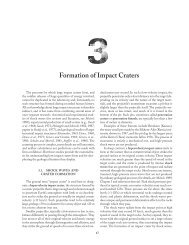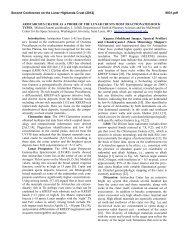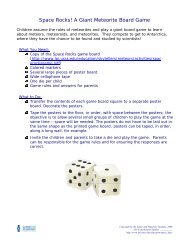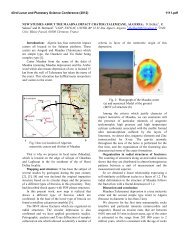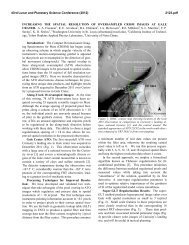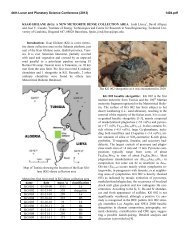Chapter 2: Energy at the Lunar Surface - Lunar and Planetary Institute
Chapter 2: Energy at the Lunar Surface - Lunar and Planetary Institute
Chapter 2: Energy at the Lunar Surface - Lunar and Planetary Institute
Create successful ePaper yourself
Turn your PDF publications into a flip-book with our unique Google optimized e-Paper software.
SOLAR ENERGY<br />
based on <strong>the</strong> present mass-frequency distribution shows.<br />
Since phase 3 of <strong>the</strong> flux history covers most of post-mare time, which<br />
accounts for over 60 per cent of lunar history, <strong>and</strong> <strong>the</strong> time during which<br />
much of <strong>the</strong> lunar soil evolved, it is instructive to look <strong>at</strong> estim<strong>at</strong>es of <strong>the</strong><br />
current meteoroid energy flux. Iridium <strong>and</strong> osmium are rare in terrestrial<br />
sediments <strong>and</strong> compar<strong>at</strong>ively more abundant in meteorites such th<strong>at</strong> <strong>the</strong>ir<br />
concentr<strong>at</strong>ions can be used as an index to <strong>the</strong> amount of meteoritic m<strong>at</strong>erial<br />
included in deep-sea sediment (Barker <strong>and</strong> Anders, 1968). By accepting <strong>the</strong><br />
chemical composition of C1 carbonaceous chondrites as being represent<strong>at</strong>ive<br />
of non-vol<strong>at</strong>ile cosmic m<strong>at</strong>ter Barker <strong>and</strong> Anders (1968) found <strong>the</strong> terrestrial<br />
accretion r<strong>at</strong>e for meteoritic m<strong>at</strong>erial to be 1.2 (k0.6) x 10-8 g cm-2 yr-1<br />
over <strong>the</strong> past 105 to 106 yr. They were also able to set a stringent upper<br />
limit on <strong>the</strong> accretion r<strong>at</strong>e by assuming th<strong>at</strong> all 0s <strong>and</strong> Ir in <strong>the</strong> sediments<br />
was cosmic. The upper limit is 2.9 x 10-8g cm-2 yr-1 . The flux on <strong>the</strong> earth is<br />
enhanced by gravit<strong>at</strong>ional focusing (f = 1.8) by comparison with <strong>the</strong> moon (f<br />
= 1.03) but <strong>the</strong> difference is well within <strong>the</strong> uncertainties <strong>at</strong>tached to <strong>the</strong><br />
above estim<strong>at</strong>es.<br />
Similarly trace element enrichment in lunar soil <strong>and</strong> soil breccia samples<br />
from <strong>the</strong> Apollo 11 site indic<strong>at</strong>ed a mass flux of 3.8 x 10-9 grn c-2 yr-1<br />
(Ganap<strong>at</strong>hy et al., 1970a). Subsequently Ganap<strong>at</strong>hy et al. (1970a, b)<br />
estim<strong>at</strong>ed <strong>the</strong> mass flux <strong>at</strong> 4 x 10-9 g cm-2 yr-1 using similar trace element<br />
studies <strong>and</strong> soil samples from <strong>the</strong> Apollo 12 site. The Apollo 11 <strong>and</strong> 12 sites<br />
are both loc<strong>at</strong>ed on mare areas so th<strong>at</strong> <strong>the</strong> flux estim<strong>at</strong>es probably represent<br />
estim<strong>at</strong>es of Hartmann's (1970) phase 3 of <strong>the</strong> flux history.<br />
Dohnanyi (1971) used <strong>the</strong> estim<strong>at</strong>es of <strong>the</strong> modern mass frequency<br />
distribution to arrive <strong>at</strong> an integr<strong>at</strong>ed mass estim<strong>at</strong>e of 2 x 10-9 cm-2 yr-1 for<br />
<strong>the</strong> moon. Gault et al. (1972) arrived <strong>at</strong> a similar figure <strong>and</strong> l<strong>at</strong>er refined <strong>the</strong><br />
figure to 1.4 x 10-9 g cm-2 yr-1 (Gault et al., 1974).<br />
From <strong>the</strong> available inform<strong>at</strong>ion <strong>and</strong> assuming a root-mean-square<br />
velocity of 20 km s-1 <strong>the</strong> post-mare energy flux from impacting meteoroids<br />
<strong>at</strong> <strong>the</strong> lunar surface has been between 2 to 8 x 103 ergs cm-2 yr-1. By<br />
comparison with <strong>the</strong> terrestrial environment this energy flux is extremely<br />
small. However, <strong>the</strong> lack of an <strong>at</strong>mosphere <strong>and</strong> <strong>the</strong> large amount of geologic<br />
time available make meteoroid impact <strong>the</strong> most effective sedimentary<br />
process on <strong>the</strong> lunar surface. The partitioning of <strong>the</strong> flux energy is complex<br />
<strong>and</strong> is dealt with in some detail in <strong>Chapter</strong> 3.<br />
Solar <strong>Energy</strong><br />
At <strong>the</strong> avarage distance of <strong>the</strong> earth-moon system from <strong>the</strong> sun <strong>the</strong>


